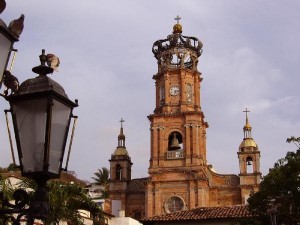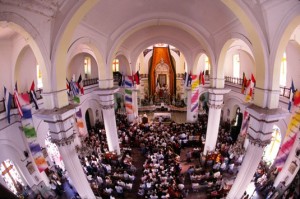Our Lady of Guadalupe Church

Standing proudly over the Zocalo, the City’s oceanside central plaza, Our Lady of Guadalupe Church, with it’s famous crown is the focal point of the Vallarta skyline. It is a symbol of Puerto Vallarta known throughout the world. It is also the focal point for the famous Festival of Our Lady of Guadalupe. The Church offers Mass daily with both English and Spanish services on weekends.
OK, So It Wasn’t Built In A Day
Construction of the Church started in1903 around a small chapel that was already there. In 1915 the decision to build a larger church was made. Due to a number of intervening issues including a war which stopped the building for a time, the main tower was not completed until 1952 and the original church crown wasn’t installed until 1963. Rumor has it that the crown is a replica of the tiara worn by Carlota, mistress of Emperor Maxamilian in the 1800’s, but she’s definitely not telling!
But They Did Do It Well!
Our Lady of Guadalupe Church is a beautiful example of local architecture and an embodiment of local spirit. It is a unique combination of several architectural styles. On the hour you can hear the magnificent sounds of the Church bells ringing from the tower. Upon entering the Church, you are struck by its splendid simplicity and the air of calm that it bestows on visitors. The plain, white-washed walls are dramatically embellished with richly detailed moldings. On a sunny day – which is most of the time in Vallarta – the sunlight shines through stained glass windows to illuminate the gilt-trimmed altar with a warm glow. During the Christmas Holidays, the Church’s hand carved columns are adorned with festive wreaths. No matter what your heritage, the solemn beauty of Our Lady of Guadalupe will touch you in a special way.
Our Lady of Guadalupe Blows Her Top
Now we know that Our Lady would never really blow her top—she’s too nice for that! But, it is true that in 1995 a strong earthquake all but destroyed the original crown, which was replaced with what some consider to be an inferior copy. This continues to be a sore point for some members of the community, who see the crown at the top of the bell tower as Puerto Vallarta’s most recognizable landmark.
Tis The Season – Our Lady Does Know How To Party!
The Virgin of Guadalupe is a significant cultural and religious image for Mexicans. On December 12, 1531 a dark skinned Virgin appeared to a Mexican peasant named Juan Diego. She identified herself as the true Mother of God, instructed him to build a church in her name, and left her image on a piece of cloth as proof of her claim—thus was born the legend of our Lady of Guadalupe. Saint Juan Diego is credited with being one of the major reasons Mexico is 85% Catholic today. The Virgin is the patron saint of Vallarta as well as all of Mexico.
 The Festival for the Virgin of Guadalupe is celebrated on December 12 to commemorate this appearance. Thousands of tourists come from around the world to enjoy this cultural and spiritual experience. Many people bring milagros to the statue of the Virgin. Milagros are small tin or silver objects in the shape of legs, arms and hearts to show thanks for a cure.
The Festival for the Virgin of Guadalupe is celebrated on December 12 to commemorate this appearance. Thousands of tourists come from around the world to enjoy this cultural and spiritual experience. Many people bring milagros to the statue of the Virgin. Milagros are small tin or silver objects in the shape of legs, arms and hearts to show thanks for a cure.
Starting around the first of December, Puerto Vallarta enters holiday mode. Locals and visitors alike participate in joyful candlelit processions with music, Aztec folk dances, drum and fife bands, kids dressed as Juan Diego, participants in traditional costumes, and elderly women in white carrying baskets of flowers and food as gifts to the Virgin; the square fills with vendors; and fireworks light up the night sky. If you want to participate, you can actually pick up candles and sheets that have words to the specific songs used in the celebration. Lots of great authentic food to sample makes this family oriented celebration complete. The tantalizing scent of tacos, black beans, and spicy chicken called mole poblano definitely awakens your appetite. The highlight of the festival is the last few days and particularly the last day. The entire festival wraps up on December 12th with a pilgrimage to the church and a special Mass in celebration of the occasion.
